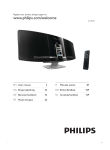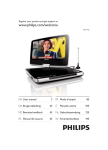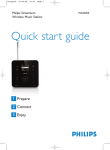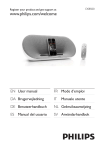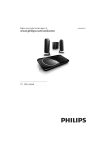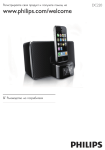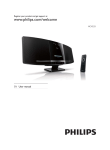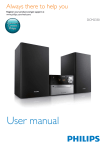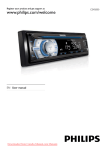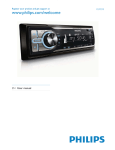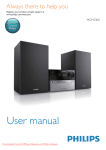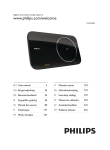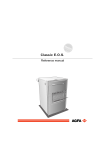Download Philips Classic micro sound system DCM377
Transcript
Register your product and get support at DCM377 www.philips.com/welcome EN User manual DCM377_05_UM_V1.1.indd 1 2010-9-29 16:46:45 1 Important Safety Notice 4 4 5 2 Your Docking Entertainment System Introduction What’s in the box Overview of the main unit Overview of the remote control 6 6 6 7 8 3 Get started Connect speakers Connect FM antenna Connect power Prepare the remote control Set clock Turn on Store radio stations automatically 9 9 9 9 10 10 10 10 4 Play Basic play operations Play from disc Play from USB Adjust sound 11 11 11 11 11 5 Play iPhone/iPod Compatible iPhone/iPod Listen to the iPhone/iPod Charge the iPhone/iPod Remove the iPhone/iPod 12 12 12 12 12 6 Listen to FM radio Tune to FM radio stations Program radio stations automatically Program radio stations manually Tune to a preset radio station Show RDS information 13 13 13 13 13 13 7 Other features Set alarm timer Set sleep timer Listen to external audio device Listen through headphone 14 14 14 14 14 8 Product information 6SHFLÀFDWLRQV USB playability information Supported MP3 disc formats 14 14 15 15 9 Troubleshooting 16 EN DCM377_05_UM_V1.1.indd 3 2010-9-29 English Contents 3 16:46:45 1 Important Safety This ‘bolt of lightning’ indicates uninsulated material within your unit may cause an electrical shock. For the safety of everyone in your household, please do not remove product covering. The ‘exclamation point’ calls attention to features for which you should read the enclosed literature closely to prevent operating and maintenance problems. :$51,1*7RUHGXFHWKHULVNRIÀUHRUHOHFWULF shock, this apparatus should not be exposed to rain RUPRLVWXUHDQGREMHFWVÀOOHGZLWKOLTXLGVVXFKDV vases, should not be placed on this apparatus. CAUTION: To prevent electric shock, match wide blade of plug to wide slot, fully insert. Do not block any ventilation openings. Install in accordance with the manufacturer’s instructions. Do not install near any heat sources such as radiators, heat registers, stoves, or other DSSDUDWXVLQFOXGLQJDPSOLÀHUVWKDWSURGXFH heat. Protect the power cord from being walked on or pinched, particularly at plugs, convenience receptacles, and the point where they exit from the apparatus. 2QO\XVHDWWDFKPHQWVDFFHVVRULHVVSHFLÀHGE\ the manufacturer. Use only with the cart, stand, tripod, bracket, or table VSHFLÀHGE\WKHPDQXIDFWXUHU or sold with the apparatus. When a cart is used, use caution when moving the cart/ apparatus combination to avoid injury from tip-over. Unplug this apparatus during lightning storms or when unused for long periods of time. 4 Refer DOOVHUYLFLQJWRTXDOLÀHGVHUYLFH personnel. Servicing is required when the apparatus has been damaged in any way, such as power-supply cord or plug is damaged, liquid has been spilled or objects have fallen into the apparatus, the apparatus has been exposed to rain or moisture, does not operate normally, or has been dropped. Battery usage CAUTION – To prevent battery leakage which may result in bodily injury, property damage, or damage to the unit: Install all batteries correctly, + and - as marked on the unit. Do not mix batteries (old and new or carbon and alkaline, etc.). Remove batteries when the unit is not used for a long time. Apparatus shall not be exposed to dripping or splashing. Do not place any sources of danger on the DSSDUDWXVHJOLTXLGÀOOHGREMHFWVOLJKWHG candles). Important notes for users in the U.K. How to connect a plug The wires in the mains lead are coloured with the following code: blue = neutral (N), brown = live (L). As these colours may not correspond with the colour markings identifying the terminals in your plug, proceed as follows: Connect the blue wire to the terminal marked N or coloured black. Connect the brown wire to the terminal marked L or coloured red. Do not connect either wire to the earth terminal in the plug, marked E (or e) or coloured green (or green and yellow). Before replacing the plug cover, make certain that the cord grip is clamped over the sheath of the lead - not simply over the two wires. Mains plug 7KLVDSSDUDWXVLVÀWWHGZLWKDQDSSURYHG$PS plug. To change a fuse in this type of plug proceed as follows: Remove fuse cover and fuse. Fix new fuse which should be a BS1362 3 Amp, A.S.T.A. or BSI approved type. ReÀWWKHIXVHFRYHU ,IWKHÀWWHGSOXJLVQRWVXLWDEOHIRU\RXUVRFNHW outlets, it should be cut off and an appropriate plug ÀWWHGLQLWVSODFH If the mains plug contains a fuse, this should have a value of 3 Amp. If a plug without a fuse is used, the fuse at the distribution board should not be greater than 3 Amp. EN DCM377_05_UM_V1.1.indd 4 2010-9-29 16:46:46 Copyright in the U.K. Recording and playback of material may require consent. See Copyright Act 1956 and The Performer’s Protection Acts 1958 to 1972. Caution Use of controls or adjustments or performance of $Q\FKDQJHVRUPRGLÀFDWLRQVPDGHWRWKLV device that are not expressly approved by Philips Consumer Lifestyle may void the user’s authority to operate the equipment. English The severed plug must be disposed off to avoid a possible shock hazard should it be inserted into a 13 Amp socket elsewhere. Your product is designed and manufactured with high quality materials and components, which can be recycled and reused. procedures other than herein may result in hazardous radiation exposure or other unsafe operation. Warning Where the MAINS plug or an appliance coupler is used as the disconnect device, the disconnect device shall remain readily operable. Hearing Safety Danger To avoid hearing damage, limit the time you use the headphones at high volume and set the volume to a safe level. The louder the volume, the shorter is the safe listening time. Be sure to observe the following guidelines when using your headphones. Listen at reasonable volumes for reasonable periods of time. Be careful not to adjust the volume continuously upwards as your hearing adapts. Do not turn up the volume so high that you can’t hear what’s around you. You should use caution or temporarily discontinue use in potentially hazardous situations. Excessive sound pressure from earphones and headphones can cause hearing loss. Notice This product complies with the radio interference requirements of the European Community. This product complies with the requirements of the following directives and guidelines: 2004/108/EC + 2006/95/EC When this crossed-out wheeled bin symbol is attached to a product it means that the product is covered by the European Directive 2002/96/EC. Please inform yourself about the local separate collection system for electrical and electronic products. Please act according to your local rules and do not dispose of your old products with your normal household waste. Correct disposal of your old product helps to prevent potential negative consequences for the environment and human health. Your product contains batteries covered by the European Directive 2006/66/EC, which cannot be disposed with normal household waste.Please inform yourself about the local rules on separate collection of batteries because correct disposal helps to prevent negative consequences for the environmental and human health. Environmental information All unnecessary packaging has been omitted. We have tried to make the packaging easy to separate into three materials: cardboard (box), polystyrene foam (buffer) and polyethylene (bags, protective foam sheet.) Your system consists of materials which can be recycled and reused if disassembled by a specialized company. Please observe the local regulations regarding the disposal of packaging materials, exhausted batteries and old equipment. EN DCM377_05_UM_V1.1.indd 5 2010-9-29 5 16:46:46 2 Your Docking Entertainment System The making of unauthorized copies of copyprotected material, including computer programs, ÀOHVEURDGFDVWVDQGVRXQGUHFRUGLQJVPD\EHDQ infringement of copyrights and constitute a criminal offence. This equipment should not be used for such purposes. “Made for iPod” means that an electronic accessory KDVEHHQGHVLJQHGWRFRQQHFWVSHFLÀFDOO\WRL3RG DQGKDVEHHQFHUWLÀHGE\WKHGHYHORSHUWRPHHW Apple performance standards. “Works with iPhone” means that an electronic DFFHVVRU\KDVEHHQGHVLJQHGWRFRQQHFWVSHFLÀFDOO\ WRL3KRQHDQGKDVEHHQFHUWLÀHGE\WKHGHYHORSHU to meet Apple performance standards. Apple is not responsible for the operation of this device or its compliance with safety and regulatory standards. iPod is a trademark of Apple Inc., registered in the U.S. and other countries. Congratulations on your purchase, and welcome to 3KLOLSV7RIXOO\EHQHÀWIURPWKHVXSSRUWWKDW3KLOLSV offers, register your product at www.philips.com/ welcome. Introduction With this unit, you can: enjoy audio from discs, USB devices, iPod, iPhone and other external devices listen to radio stations You can enrich sound output with these sound effects: Digital Sound Control (DSC) Dynamic Bass Boost (DBB) Loudness Control The unit supports these media formats: Norge 7\SHVNLOWÀQQHVSnDSSDUDWHQVXQGHUVLGH Observer: Nettbryteren er sekundert innkoplet. Den innebygde netdelen er derfor ikke frakoplet QHWWHWVnOHQJHDSSDUDWHWHUWLOVOXWWHWQHWWNRQWDNWHQ )RUnUHGXVHUHIDUHQIRUEUDQQHOOHUHOHNWULVNVW¡W skal apparatet ikke utsettes for regn eller fuktighet. This apparatus includes this label: What’s in the box Note The type plate is located on the bottom of the apparatus. 6 Check and identify the contents of your package: Main unit Remote control with battery Speaker boxes (×2) FM antenna Power cable MP3 link cable (60cm) User manual EN DCM377_05_UM_V1.1.indd 6 2010-9-29 16:46:47 English Overview of the main unit p o n m l k a j i h b c g f d e a VOLUME Adjust volume. b DSC Select a preset sound setting. c DBB Turn on or off dynamic bass enhancement. d USB socket. h OPEN/CLOSE Open or close the disc tray. i SOURCE Select a source. j ALBUM/PRESET / Skip to previous/next album. Select a preset radio station. Navigate through iPod/iPhone menu. k e MP3 LINK Connect external audio device. f Headphone socket. g Disc tray / Skip to previous/next track. Search within a track/disc. Tune to a radio station. Stop play. Erase a program. l EN DCM377_05_UM_V1.1.indd 7 2010-9-29 7 16:46:49 m a Start or pause play. n Display panel Show current status. o Turn on the apparatus, switch to standby mode, or Eco Power standby mode. p Dock for iPhone / iPod Turn on the unit. Switch to standby or Eco Power standby mode. b Source selection keys (CD, USB, FM, iPhone, iPod, AUX, MP3 LINK) Select a source. c RDS For selected FM radio stations: display RDS information. Synchronize clock with RDS station. Overview of the remote control d DISPLAY Display play information. a CD USB FM MP 3 LINK REPEAT SHUFFLE b DISPLAY d e ALBUM/PRESET u f OK LOUDNESS MENU VOL g ALBUM/PRESET / Skip to previous/next album. Select a preset radio station. Navigate through iPod/iPhone menu. h MENU Access iPod/iPhone menu. i VOL +/ Adjust volume. j MUTE Mute volume. h k DIM Adjust brightness of display panel. i DBB q 1 2 3 MUTE j 4 5 6 DIM k 7 8 9 CLOCK l PROG 0 SHIFT TIMER p Skip to previous/next track. Search within a track/disc. Tune to a radio station. g DSC r / c w v SLEEP o f RDS AUX OPEN/CLOSE t s e SHUFFLE Play tracks randomly. m n l CLOCK Set clock. m SLEEP/TIMER Set sleep timer. Set alarm timer. n SHIFT Enter a two or three-digit number (used with the numeric keypad). o PROG Program tracks. Program radio stations. p Numeric keypad Select a track directly. q 8 Stop play. Erase a program. EN DCM377_05_UM_V1.1.indd 8 2010-9-29 16:46:50 English r DSC/DBB Select a preset sound setting. Turn on or off dynamic bass enhancement. s Start or pause play. t LOUDNESS Enable or disable automatic loudness adjustment. u OK &RQÀUPDVHOHFWLRQ v REPEAT Select a repeat play mode. w OPEN/CLOSE Open or close the disc tray. Connect FM antenna 3 Get started Caution Use of controls or adjustments or performance of procedures other than herein may result in hazardous radiation exposure or other unsafe operation. Always follow the instructions in this chapter in sequence. If you contact Philips, you will be asked for the model and serial number of this apparatus. The model number and serial number are on the bottom of the apparatus. Write the numbers here: Model No. __________________________ Serial No. ___________________________ Connect speakers Tip For optimal reception, fully extend and adjust the position of the antenna. For better FM stereo reception, connect an outdoor FM antenna to the FM ANTENNA socket. The unit does not support MW radio reception. Note For optimal sound, use the supplied speakers only. Connect only speakers with impedance that is the 1 same or higher than the supplied speakers. Refer to the 6SHFLÀFDWLRQVVHFWLRQRIWKLVPDQXDO 1 Connect the supplied FM antenna to the FM ANTENNA socket on the main unit. Connect power Insert the speaker wires completely into the speaker input sockets on the back of the unit. Caution Risk of product damage! Ensure that the power supply voltage corresponds to the voltage printed on the back or the underside of the unit. Risk of electric shock! When you unplug the AC power cord, always pull the plug from the socket. Never pull the cord. Before you connect the AC power cord, ensure that you have completed all other connections. EN DCM377_05_UM_V1.1.indd 9 2010-9-29 9 16:46:51 Note If you are not going to use the remote control for a long time, remove the battery. Set clock 1 Connect the power cable to: the AC~ jack on the main unit. the wall socket. Prepare the remote control 1 In standby mode, press CLOCK for 3 seconds to activate clock setting mode. » [SET CLOCK] scrolls on the display, then the time format [24H] and [12H] appears. 2 Press ALBUM/PRESET to select 24H or 12H, then press CLOCKWRFRQÀUP » The hour digits begin to blink. 3 Press ALBUM/PRESET to set hour, then press CLOCK again. » The minute digits begin to blink. 4 5 Press ALBUM/PRESET to set minute. Press CLOCKWRFRQÀUPWKHFORFNVHWWLQJ Caution Note Risk of explosion! Keep batteries away from heat, VXQVKLQHRUÀUH1HYHUGLVFDUGEDWWHULHVLQÀUH )RUÀUVWWLPHXVH 1 Remove the protective tab to activate the remote control battery. To replace the remote control batteries: If no button is pressed in 30 seconds, the system exits clock setting mode automatically. Turn on 1 Press . » The unit switches to the last selected source. Switch to standby mode 1 Press for over 3 seconds to switch the unit to Eco Power Standby mode. » The backlight on the display panel turns off. » The blue Eco Power indicator turns on. To switch the unit to standby mode: In Eco Power Standby mode, press for over 3 seconds. » The clock (if set) appears on the display panel. » The blue Eco Power indicator turns off. 1 1 2 3 Open the battery compartment. Insert one lithium CR2025 battery with correct polarity (+/-) as indicated. Close the battery compartment. 10 EN DCM377_05_UM_V1.1.indd 10 Store radio stations automatically When the unit is connected to power and no radio stations are stored, the unit begins to store radio stations automatically. 1 Connect the unit to power supply. » [AUTO INSTALL PRESS--PLAY KEY](auto install press - play key) is displayed. 2010-9-29 16:46:51 Press to start storing. » The unit automatically stores radio stations ZLWKVXIÀFLHQWVLJQDOVWUHQJWK » When all the available radio stations are VWRUHGWKHÀUVWSUHVHWUDGLRVWDWLRQLV broadcast automatically. Play from USB English 2 4 Play Basic play operations You can control play through following operations. Key / DISPLAY REPEAT SHUFFLE Function 7RVHOHFWDWUDFNRUÀOH Press and hold to fast-forward/fastreverse the track during playback, then release to resume play. To pause/resume play during playback. To select different play information. To select a repeat play mode: [REP] (repeat): play current track repeatedly. [REP ALL] (repeat all): play all tracks repeatedly. [REP] (repeat) and [ALB] (album) (for MP3 and USB only): play the current album repeatedly. Press again to return to normal play. To play tracks randomly. Press again to return to normal play. Play from disc 1 2 Press CD to select the CD source. Press OPEN/CLOSE. » The disc compartment opens. 3 Place a disc with the printed side facing up, then press OPEN/CLOSE. Play starts automatically. If play does not start, press / to select a track, then press . 4 Warning Ensure that the USB device contains playable audio contents for supported formats. 1 2 3 Flip open the cover marked on the front panel. Insert the USB device into the USB socket. Press USB to select the USB source. » Play starts automatically. If not, press ALBUM/PRESET to select a folder and / WRVHOHFWDÀOH7KHQSUHVVOK to start play. Adjust sound During play, you can adjust volume through following operations. Key VOL +/MUTE LOUDNESS DBB DSC Function To increase/decrease the volume. To mute/restore sound. To turn on/off automatic loudness control. To turn on or off dynamic bass enhancement. If DBB is activated, [DBB] is displayed. To select your desired sound effect: [POP] (pop) [JAZZ] (jazz) [ROCK] (rock) [FLAT]ÁDW [CLASSIC] (classic) EN DCM377_05_UM_V1.1.indd 11 11 2010-9-29 16:46:52 5 Play iPhone/iPod You can enjoy audio from iPhone/iPod through this unit. Compatible iPhone/iPod The unit supports the following iPod and iPhone models: Made for. iPod classic iPod with color display iPod with video iPod nano (1st/2nd/3rd/4th/5th generation) iPod Touch (1st/2nd/3rd generation) Works with. iPhone iPhone 3G iPhone 3GS Listen to the iPhone/iPod 1 2 Press iPhone/iPod to select the iPhone/iPod source. Open the iPhone/iPod dock on the top panel. To pause/resume play, press . To skip to a track, press / . To search during play: press and hold / , then release to resume normal play. To navigate the menu: press MENU and / to select, then press OKWRFRQÀUP Note When iPod/iPhone source is selected, you cannot enjoy audio through the headphone socket. Charge the iPhone/iPod When the unit is connected to power, the docked iPhone/iPod begins to charge. Remove the iPhone/iPod 3 Place the iPhone/iPod in the dock. 12 EN DCM377_05_UM_V1.1.indd 12 1 2 Pull the iPhone/iPod out of the dock. Press down to hide the dock. 2010-9-29 16:46:53 4 Repeat steps 2-3 to program other stations. English 6 Listen to FM radio Note Tune to FM radio stations To overwrite a programmed station, store another station in its place. Warning Ensure that you have connected and fully extended the supplied FM antenna. 1 2 3 Press FM. Press and hold / to tune to a radio station. When the frequency starts to change, release the button. » The FM tuner tunes to a station with strong reception automatically. 4 Repeat steps 2-3 to tune to more stations. To tune to a weak station: Press / UHSHDWHGO\XQWLO\RXÀQGRSWLPDO reception. Program radio stations automatically Note 1 Press / to select a preset number. Show RDS information RDS (Radio Data System) is a service that allows FM stations to show additional information. If you tune to a RDS station, a RDS icon and the station name are displayed. 1 Tune to a RDS station. 2 Press RDS repeatedly to scroll through the following information (if available): » Station name » Program type such as [NEWS] (news), [SPORT] (sport), [POP M] (pop music)... » RDS clock » Frequency Synchronize clock with RDS You can program a maximum of 20 preset radio stations. 1 Tune to a preset radio station In FM tuner mode, press PROG for 3 seconds to activate automatic programming. » [AUTO] (auto) is displayed. » The unit automatically stores radio stations ZLWKVXIÀFLHQWVLJQDOVWUHQJWK » When all the available radio stations are VWRUHGWKHÀUVWSUHVHWUDGLRVWDWLRQLV broadcast automatically. Program radio stations manually You can synchronize time shown on the unit with that on the RDS station. 1 Tune to a RDS radio station that transmits time signals. 2 Press RDS for over 2 seconds. » [CT SYNC] is displayed and the unit reads RDS time automatically. » If no time signal is received, [NO CT] is displayed. Note The accuracy of the transmitted time depends on the RDS station that transmits the time signal. Note You can program a maximum of 20 preset radio stations. 1 2 3 Tune to a radio station. Press PROG to activate programming mode. Press / to select a number from 1–20 for this radio station, then press PROG to FRQÀUP » The preset number and the frequency of the preset station are displayed. EN DCM377_05_UM_V1.1.indd 13 13 2010-9-29 16:46:53 7 Other features Set sleep timer 1 Set alarm timer This unit can be used as an alarm clock. You can select CD, iPod/iPhone, iPod/iPhone playlist, FM or USB as alarm source. Note Make sure that you have set the clock correctly. 1 In standby mode, press and hold TIMER until [SET TIMER] (set timer) scrolls on the display. » [SELECT SOURCE] (select source) scrolls on the screen. 2 Press SOURCE repeatedly to select a source: CD, FM, USB, iPod/iPhone or iPod/iPhone playlist. If iPod/iPhone playlist is selected as alarm source, you need create a playlist called “PHILIPS” in your iPod/iPhone. If no playlist called “PHILIPS” is created in the iPod/iPhone or no track is stored in the playlist, the unit switches to iPod/ iPhone alarm source. Press TIMERWRFRQÀUP » The hour digits are displayed and begin to blink. 3 4 Press / repeatedly to set hour, then press TIMERDJDLQWRFRQÀUP » The minute digits are displayed and begin to blink. 5 Press / to set minute, then press TIMER to FRQÀUP » VOL (volume) is displayed and begins to blink. 6 Press / to adjust volume, then press TIMERWRFRQÀUP » A clock icon is displayed. Activate/deactivate alarm timer 1 In standby mode, press TIMER repeatedly to activate or deactivate timer. » If timer is activated, is displayed. Tip When the unit is turned on, press SLEEP repeatedly to select a time period (in minutes). » When sleep timer is activated, is displayed. » To deactivate sleep timer, press SLEEP again until disappears. Listen to external audio device You can listen to an external audio device such as MP3 player through this unit. 1 Connect the audio device. For audio device with red/white audio output sockets: Connect a red/white audio cable (not supplied) to the AUX IN sockets and to the audio output sockets on the audio device. For audio device with headphone sockets: Connect the supplied MP3 Link cable to the MP3 LINK socket and to the headphone socket on the audio device. 2 Select MP3 LINK/AUX source. 3 Play the device. Listen through headphone 1 Plug a headphone into the unit. socket on the 8 Product information Note Product information is subject to change without prior notice. 6SHFLÀFDWLRQV $PSOLÀHU Rated Output Power Frequency Response Signal to Noise Ratio Aux Input 2X50W RMS 30Hz-20kHZ G% 1V RMS 20kohm Alarm timer is not available in MP3 LINK mode. If CD/USB/iPod/iPhone source is selected, yet no disc is placed or no USB/iPod/iPhone connected, the system switches to the tuner source automatically. 14 EN DCM377_05_UM_V1.1.indd 14 2010-9-29 16:46:54 Disc USB playability information Audio DAC Total Harmonic Distortion Frequency Response S/N Ratio Semiconductor 12cm/8cm CD-DA, CD-R, CD-RW, MP3-CD, WMA-CD 16Bits / 44.1kHz <1% (1 kHz) 4Hz - 20kHz (44.1kHz) >75dBA Tuner (FM) Tuning Range Tuning grid Sensitivity - Mono, 26dB S/N Ratio - Stereo, 46dB S/N Ratio Search Selectivity Total Harmonic Distortion Signal to Noise Ratio 87.5 - 108MHz 50 KHz <22 dBf >43 dBf >28 dBf <3% >55 dB Speakers Speaker Impedance Speaker Driver Sensitivity 6 ohm 5” woofer + 1” tweeter >85dB/m/W General information AC power Operation Power Consumption Eco Standby Power Consumption Audio Output Headphone Output USB Direct Dimensions - Main Unit (W x H x D) - Speaker Box (W x H x D) Weight - With Packing - Main Unit - Speaker Box 220 - 240V, 50/60Hz 35W : 1Vpp ± 0.1Vpp 3.5kohm 2x15mW 32ohm Version 2.0 FS Compatible USB devices: USBÁDVKPHPRU\86%RU86% 86%ÁDVKSOD\HUV86%RU86% memory cards (requires an additional card reader to work with this unit) Supported formats: U6%RUPHPRU\ÀOHIRUPDW)$7)$7 FAT32 (sector size: 512 bytes) MP3 bit rate (data rate): 32-320 Kbps and variable bit rate WMA v9 or earlier Directory nesting up to a maximum of 8 levels Number of albums/ folders: maximum 99 Number of tracks/titles: maximum 999 ID3 tag v2.0 or later File name in Unicode UTF8 (maximum length: 64 bytes) Unsupported formats: Empty albums: an empty album is an album WKDWGRHVQRWFRQWDLQ03:0$ÀOHVDQGLV not be shown in the display. 8QVXSSRUWHGÀOHIRUPDWVDUHVNLSSHG)RU H[DPSOH:RUGGRFXPHQWVGRFRU03ÀOHV with extension .dlf are ignored and not played. $$&:$93&0DXGLRÀOHV '50SURWHFWHG:0$ÀOHVZDYPDPS .mp4, .aac) :0$ÀOHVLQ/RVVOHVVIRUPDW Supported MP3 disc formats ISO9660, Joliet 0D[LPXPWLWOHQXPEHUGHSHQGLQJRQÀOH name length) Maximum album number: 255 Supported sampling frequencies: 32 kHz, 44.1kHz, 48 kHz Supported Bit-rates: 32~320 (kbps), variable bit rates 160 x 242 x 237mm 160 x 242 x 222mm 10 kg 2 kg 2.85 x 2 kg EN DCM377_05_UM_V1.1.indd 15 English Laser Type Disc Diameter Support Disc 15 2010-9-29 16:46:54 9 Troubleshooting Warning Never remove the casing of this apparatus. To keep the warranty valid, never try to repair the system yourself. If you encounter problems when using this apparatus, check the following points before requesting service. If the problem remains unsolved, go to the Philips web site (www.philips.com/welcome). When you contact Philips, ensure that the apparatus is nearby and the model number and serial number are available. No power Ensure that the AC power cord of the unit is connected properly. Ensure that there is power at the AC outlet. As a power-saving feature, the system switches off automatically 15 minutes after track play reaches the end and no control is operated. No sound or poor sound Adjust the volume. Disconnect the headphones. Check that the speakers are connected correctly. Check if the stripped speaker wires are clamped. Wait until the moisture condensation at the lens has cleared. Replace or clean the disc. 8VHDÀQDOL]HG&'RUFRUUHFWIRUPDWGLVF &DQQRWGLVSOD\VRPHÀOHVLQ86%GHYLFH 7KHQXPEHURIIROGHUVRUÀOHVLQWKH86% device has exceeded a certain limit. This phenomenon is not a malfunction. 7KHIRUPDWVRIWKHVHÀOHVDUHQRWVXSSRUWHG USB device not supported The USB device is incompatible with the unit. Try another one. Poor radio reception Increase the distance between the unit and your TV or VCR. Fully extend the FM antenna. Connect an outdoor FM antenna instead. Timer does not work Set the clock correctly. Switch on the timer. Clock/timer setting erased Power has been interrupted or the power cord has been disconnected. Reset the clock/timer. No response from the unit Disconnect and reconnect the AC power plug, then turn on the unit again. As a power-saving feature, the system switches off automatically 15 minutes after track play reaches the end and no control is operated. Remote control does not work %HIRUH\RXSUHVVDQ\IXQFWLRQEXWWRQÀUVW select the correct source with the remote control instead of the main unit. Reduce the distance between the remote control and the unit. Insert the battery with its polarities (+/– signs) aligned as indicated. Replace the battery. Aim the remote control directly at the sensor on the front of the unit. No disc detected Insert a disc. Check if the disc is inserted upside down. 16 EN DCM377_05_UM_V1.1.indd 16 2010-9-29 16:46:55 © 2010 Koninklijke Philips Electronics N.V. All rights reserved. DCM377_05_UM_V1.1 DCM377_05_UM_V1.1.indd 27 2010-9-29 16:46:43
















